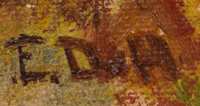Elizabeth Willis DeHuff (1886 – 1983)
+ Add Artist to My Preferences

Elizabeth Willis DeHuff (1886 – 1983) was a painter, teacher and author who was instrumental in the artistic development of many early notable pueblo painters. She attended school at Athens, Georgia’s, Lucy Cobb Institute and then received a teaching degree from Barnard College. While teaching in the Philippines, she met Carlisle Indian School employee John David DeHuff, who would become her husband. In 1916, they moved to Santa Fe, where John became superintendent of the Santa Fe Indian School. She quickly became enamored with Native culture, and began teaching painting in her home. The Bureau of Indian Affairs had prevented the Indian School from doing so, and so she took it upon herself to offer lessons to aspiring Native artists.
Awa Tsireh, Fred Kabotie, Velino Herrera, and Otis Polelonema were among DeHuff’s early students. She encouraged these young men and other students to document and recreate tribal ceremonies through their art. Controversy began to surround her efforts, as some community members believed that she was promoting paganism. Today, this controversy is recognized as having been misguided.
Elizabeth and John DeHuff are regarded as positive forces in the development of early pueblo painting. Their instruction, patronage, and friendship had a major impact during a time of significant change. Elizabeth went on to publish books which included illustrations by some of the aforementioned artists. She also amassed a significant collection of pueblo artwork. She remained a friend and supporter of many of her students throughout the rest of her life. DeHuff passed away in 1983.
The most visible evidence of DeHuff’s success as an artist and educator is the success of her students. To have been able to guide artists like Awa Tsireh and Fred Kabotie, she must have been quite skilled herself.

